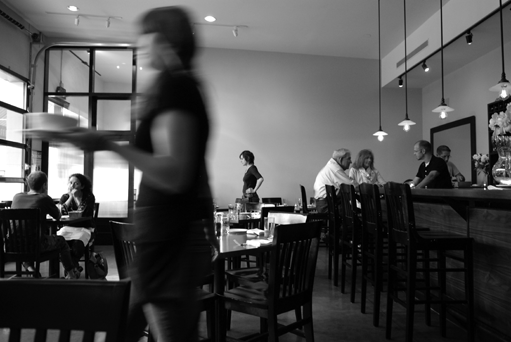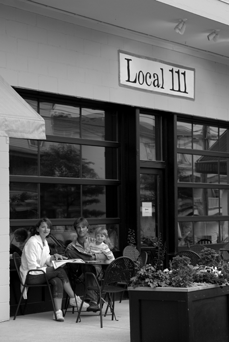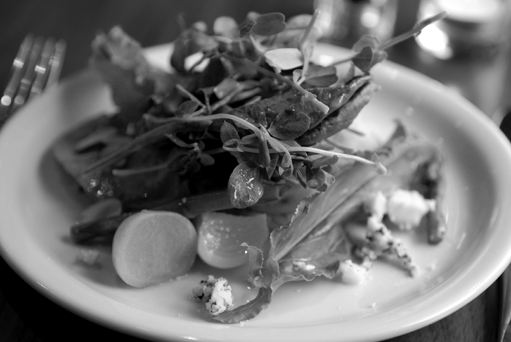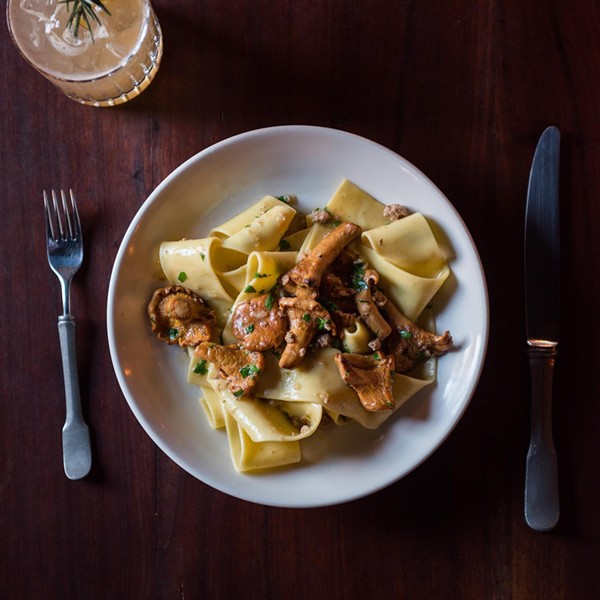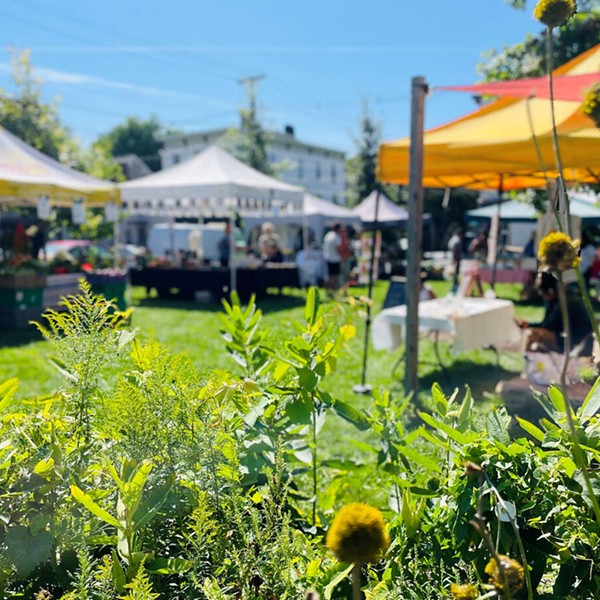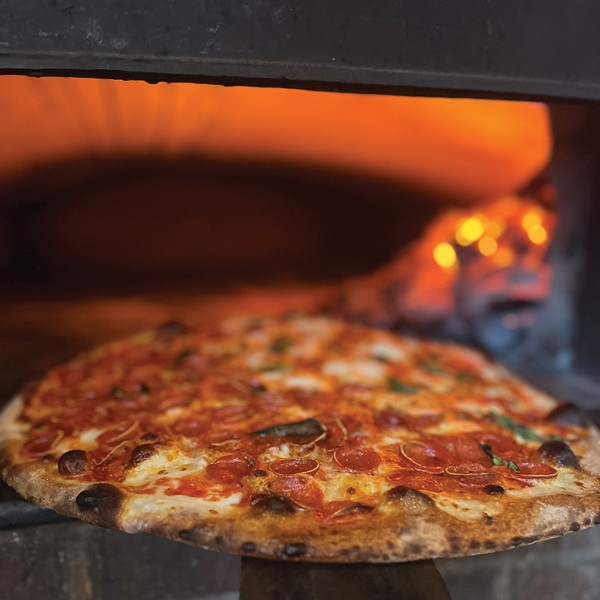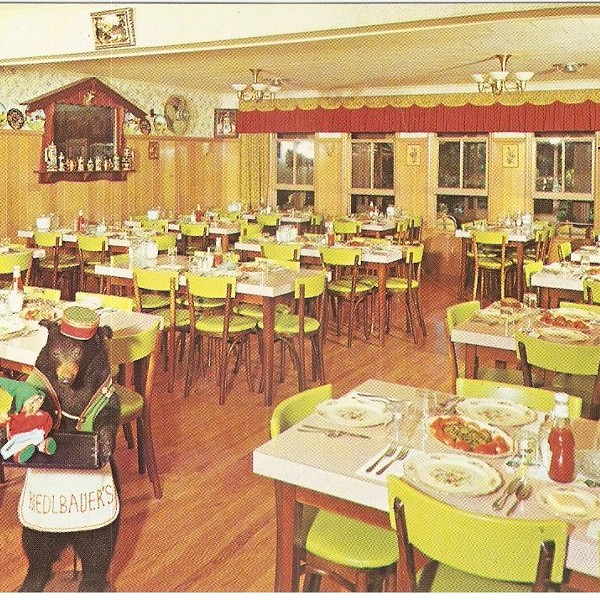The modernist design movement Bauhaus, associated with simplified forms and rational function, dismantled the boundaries between fine and applied arts. Its concepts come to mind when dining at Local 111, a restaurant housed in a former service station in the Columbia County village of Philmont. Local 111’s chef, David Wurth, uses the bistro’s close proximity to regional farmland to create new, rustic American cuisine that emphasizes local organic and grass-fed ingredients. The 39-seat eatery’s architectural elements also typify the Bauhaus idea that industrial materials and practical techniques may be reconciled with an individualist spirit and aesthetic.
Drawn to upstate farm culture, Local 111’s owners, transplanted Manhattanites Linda Gatter and Max Dannis, purchased the then-abandoned Schermerhorn’s Garage on impulse in 2004, motivated by a lecture about the revitalization of main streets delivered at the village hall. “We didn’t know what to do with it at first,” says Gatter, speaking in her airy, daylight-brightened establishment, which has been in operation since August 2006. “But we loved this walkable village of 1,200 people and wanted to contribute to its main-street vitality.”
Despite having no prior experience in food service, the couple decided to convert the building into a restaurant—part destination eatery, part local hangout. Gatter, an architect who graduated from MIT in the 1980s, came up with the design: an “adaptive” restoration. “For every project I try to think, ‘What does the space want to become?,’” she explains. “This is a service station, so I didn’t want to make it a farmhouse. I was aiming for something approachable, serene, clear, and not boring.”
Viewed from a Stewart’s Shop located directly across from its Main Street location, Local 111 (the name merges the concepts of “openness” and “accessibility” with the street address) looks like its former incarnation’s bohemian doppelgänger, in keeping with the tiny hill town’s farrago of sporadically rundown 20th-century storefronts and renovated Victorians. Framed by original cement blocks, now painted a soothing cream-beige and joined by a mocha lintel, the facade is still dominated by mullioned-glass, roll-down garage doors. Adjacent cedar planters create an affable boundary between the parking lot and a dog-friendly patio with seating for 20, suitable for sipping morning latte and relishing a freshly baked scone, while, as Gatter says, “watching who gets a speeding ticket.” The exterior’s details include the pin-striped awnings that flank the garage doors, above which the restaurant’s humble, block-lettered sign suggests that of a firehouse. In the evenings, subtle overhang lighting illuminates the mise-en-scène.
The main entrance opens onto a foyer refurbished in local black walnut and including a built-in bench. Plush, burnt-orange drapes along the far wall provide a dash of glamour. The opposite-facing walls are graced by large windows; installed across one, as if by Christo, a billowy scrim creates a grid between antechamber and dining room.
Accessed across a door-less threshold, a sense of expansiveness permeates the cozy central eating area, its stone-ground, earth-colored interior rising 13 feet. A discretely placed mirror provides the illusion of additional space while a ceiling fan, salvaged from the service station, heightens the effects of minimalist decor. Buffed and sprayed to achieve a yellow-tinted, marble-like finish and now featuring a radiant heating system, poured-concrete floors have replaced the grease pits. Bounded by a garage door, a row of dark leather banquettes forms an agreeable sightline along a far wall, complementing a singular artwork that stretches its length. Commissioned by Gatter and Dannis to capture the spirit of the surrounding rural landscape, The Promise of Light (2006), an oil painting by Great Barrington, Massachusetts, artist Gabrielle Senza, depicts a pastoral view looking north from Craryville, New York.
Made of mixed materials that evoke the industrial heritage of Philmont and crowned by a slotted wine rack spangled with miniature luminaries, the bar centers and unifies the main room. “I wanted something more rugged for the bar,” says Gatter, who hired a local steelworker to fabricate its frame and a Hillsdale, New York, woodworker to craft walnut and plywood into the top and underside, outfitting it with a foot rail. Edged in steel, square wooden tables elsewhere in the dining room repeat the bar’s patterning. Behind where a server would stand, a diner-style analogue clock floats on a backboard above a countertop where a chrome espresso machine rests like a combine in the garden.
Projecting an inviting ambiance, the ingenuity of the building’s redesign is reinforced by Chef Wurth’s inventively prepared, less-is-more food. A graduate of the Restaurant School in Philadelphia during a time when cooking was considered a trade skill as much as a culinary art, he nevertheless set out to elevate basic technique to fine craft, seeking an inspired and elegant, yet straightforward form. In 1986, Wurth found work in a small, open-kitchen Philadelphia restaurant that served seasonal local food. He became an advocate of Alice Waters-style unfussy, ingredient-driven recipes, also finding inspiration in provincial French and Italian dishes.
Wurth landed in the Big Apple in 1990, and for the next decad worked as sous chef at Savoy. “They were getting almost all their produce from green markets supplied by growers from up here,” he recalls, which induced him to move nearer to the original source. Twin principles presently define his cooking philosophy at Local 111: “Let the ingredient guide you; it will tell you what to do. Get to know your local farmers and trust that they are doing right by their animals and fields.” Grateful for regular deliveries from neighboring Threshold Farm, and supplemented by an expanding roster of regional purveyors, Wurth likewise consults his CIA-trained sous chef, Brian Williams, formerly of Aubergine in Hillsdale, in protean menu planning. He also benefits from contemporary food writing, lately Rogers Gray Italian Country Cookbook.
Dining at Local 111 is typically a bustling community affair. Its convivial bar crowd is a boon to lone diners and its children’s menu is welcoming to families. Soothing jazz wafts through the sound system as an efficient team of locals overseen by front-house manager Tim Deak warmly attend to patrons. Though the eatery’s location (200 yards from a church) prohibits a full-beverage license, its limited yet savvy selection of potent potables includes winsome sherry or sake cocktails as well as such artisan beers, such as Sierra Nevada Pale Ale ($2.50) and 16-ounce draft Chatham Porter ($4). Focused without being intimidating, French and Italian red wines by the bottle range from Vrac Cotes du Rhone ($15) to Aleramici Brunello Di Montalcino ($55, the most costly). From among four whites one may choose Chardonnay or Riesling, along with Chateau Haut Rian Bordeaux, all dry, crisp, and delicious at $4.75 by the glass.
The central attraction at Local 111 remains the kitchen’s honest, well-portioned and reasonably priced variations on familiar dishes. According to Wurth, “A restaurant should be affordable enough so that the farmer who delivers fennel in the morning on his tractor can come back later for fennel salad.” Exalting even the humblest food group’s most basic elements through tiny accents, he offers hamburgers and pork sandwiches ($8) on store-baked hard rolls, accompanied by blanched then fried-to-order russet potatoes tossed in salt seasoned with crushed rosemary and paired with a salad comprised of 90-percent mixed greens (red or green oak, romaine, arugula, wild nettle, heirloom lettuce, and others) finished with a judicious amount of olive oil, herb vinegar, sea salt, and vegetable puree. Another recently featured salad combined white beans and sheep’s ricotta with asparagus spears, sublimely fixed between raw and cooked and arranged like teepee poles over a log-pile of garlic-infused, oven-steamed fingerling potatoes and topped with a drizzle of lemon and olive oil.
The soup of the day might sound offbeat, as in an eggplant recipe that began as rich and buttery liquid, fortified by a zing of crumbled goat cheese and laced with chiffons of Italian parsley adding depth to the central vegetable’s already creamy texture ($5). Other subtle manipulations involve using store-made condiments. For instance, a spoonful of classic Spanish romesco sauce (chilies, olive oil, canned tomato, garlic, and breadcrumbs) becomes a tiny pedestal for enhancing a plate of sea scallops with background heat and a smoky, underlying flavor. In preparing duck confit ($8), Wurth keeps his attention on the shredded texture of the essential boned meat, tossing it with dandelion greens and sauteed carrots and finishing with a melange of rosemary and cherry vinegar to create various levels of crunchiness and savory sweetness.
Served with choice of two hefty vegetable sides, rotating entrees extend to nightly variations on familiar land, sea, and air dishes reminiscent of European peasant food. The chewy, grass-fed consistency of grilled steak ($22) may take some getting used to, though it is pleasingly graced with a red-wine reduction and quietly sweetened with butter, black peppercorn, and caramelized shallots to echo Old World au poivre. In contrast, the addicting taste of a springtime offering of Chatham cod ($22) unfolded gradually, sensitively layered with clams, barley, fiddleheads, and bacon and elevated by a whole artichoke prepared a la Greque, a light pickling method involving steaming and searing. Pan-roasted chicken ($19) results in bright, sharp notes when its beautiful juices release into seasonal herbs such as aromatic lovage. Vegetarians, meanwhile, may order a medley of three vegetables, such as honey-glazed carrots, grilled beats, and steamed kale, accompanied by grilled bread ($8).
Dessert master Heather Morris’s homemade baked goods are equally inventive; for instance, cornmeal almond cake ($6) married to citron curd and candied lemon slices simmered in sugar syrup to cut their tartness. Since Local 111 also runs a continental breakfast cafe on weekday mornings, Morris concocts a changing roster of bakery items, including muffins, sweetbreads, and sticky buns, offered alongside egg sandwiches and coffeehouse-inspired drinks.
“Stylistically, it’s a restaurant that speaks for itself. It’s an old garage with tables and chairs,” says Wurth. And the food? “Well, we went to the farm that day and got the stuff.” As if voicing Local 111’s motto, Gatter adds, “We’re our own little biosphere.”
Local 111 is located at 111 Main St. in Philmont, New York. Dinner is served Wednesday through Sunday from 5-9pm and Friday and Saturday until 9:30pm. (Reservations are recommended.) The restaurant operates a continental cafe Wednesday through Sunday from 8am-12pm.
(518) 672-7801; www.local111.com.







